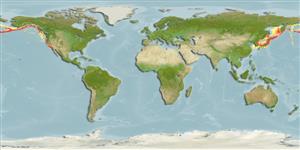Environment: milieu / climate zone / depth range / distribution range
Ecología
marino batidemersal; rango de profundidad 28 - 2189 m (Ref. 50610). Deep-water; 66°N - 32°N
North Pacific: Sea of Okhotsk, Pacific Ocean off northern Honshu and Hokkaido to Kuril Islands and southeastern Kamchatka, Commander Islands, eastern Aleutian Islands, and southern California, USA.
Tamaño / Peso / Age
Maturity: Lm ? range ? - ? cm
Max length : 8.8 cm SL macho / no sexado; (Ref. 26773)
Short description
Claves de identificación | Morfología | Morfometría
Espinas dorsales (total) : 0; Radios blandos dorsales (total) : 63 - 65; Espinas anales: 0; Radios blandos anales: 58; Vértebra: 68. Pectoral fin deeply notched; caudal fin very slender (Ref. 28160).
Life cycle and mating behavior
Maturities | Reproducción | Spawnings | Egg(s) | Fecundities | Larva
Kido, K., 1988. Phylogeny of the family Liparididae, with the taxonomy of the species found around Japan. Mem. Fac. Fish. Hokkaido Univ. (35)2:125-256. (Ref. 28160)
IUCN Red List Status (Ref. 130435)
Threat to humans
Harmless
Human uses
Herramientas
Special reports
Download XML
Fuentes de Internet
Estimates based on models
Preferred temperature (Ref.
123201): 0.3 - 5.2, mean 3.1 °C (based on 184 cells).
Phylogenetic diversity index (Ref.
82804): PD
50 = 0.7500 [Uniqueness, from 0.5 = low to 2.0 = high].
Bayesian length-weight: a=0.00525 (0.00237 - 0.01161), b=3.15 (2.96 - 3.34), in cm total length, based on LWR estimates for this (Sub)family-body shape (Ref.
93245).
Nivel trófico (Ref.
69278): 3.4 ±0.5 se; based on size and trophs of closest relatives
Resiliencia (Ref.
120179): Alto, población duplicada en un tiempo mínimo inferior a 15 meses (Preliminary K or Fecundity.).
Fishing Vulnerability (Ref.
59153): Low vulnerability (10 of 100).
